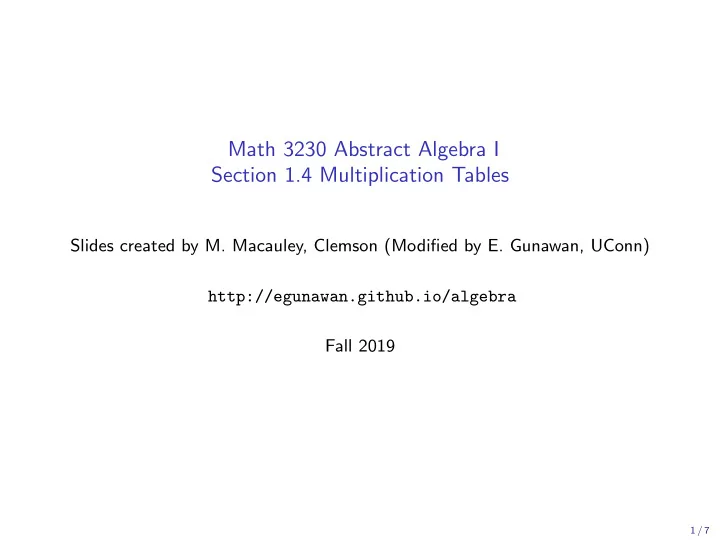

Math 3230 Abstract Algebra I Section 1.4 Multiplication Tables Slides created by M. Macauley, Clemson (Modified by E. Gunawan, UConn) http://egunawan.github.io/algebra Fall 2019 1 / 7
Multiplication tables Since we can use a Cayley diagram with nodes labeled by actions as a “group calculator,” we can create a (group) multiplication table, that shows how every pair of group actions combine. Order of multiplication can matter, so we pick the convention that the entry in row g and column h is the element gh . Example: a multiplication table for V 4 . e v r h e h e e v r h v v e r h r e v h h r r v e h v r Group Explorer software: https://nathancarter.github.io/group-explorer/GroupExplorer.html 2 / 7
Some remarks on the structure of multiplication tables Comments The 1st column and 1st row repeat themselves. (Why?) Sometimes these will be omitted ( Group Explorer does this). Multiplication tables can visually reveal patterns that may be difficult to see otherwise. Color the boxes to make these patterns more obvious. A group is abelian iff its multiplication table is symmetric about the “main diagonal.” In each row and each column, each group action occurs exactly once. (This will always happen. Why? See the next slide) 3 / 7
A theorem and proof Theorem An element cannot appear twice in the same row of a multiplication table. Proof Suppose that in row a , the element g appears in columns b and c . Algebraically, this means ab = g = ac . Multiplying everything on the left by a − 1 yields a − 1 ab = a − 1 g = a − 1 ac . This implies that b = c . Thus, the element g cannot appear twice in the same row. � The proof that two elements cannot appear twice in the same column is similar, and will be left as a homework exercise. 4 / 7
Another example: D 3 Let’s fill out a multiplication table for the group D 3 ; here are several different presentations: D 3 = � r , f | r 3 = e , f 2 = e , rf = fr 2 � = � r , f | r 3 = e , f 2 = e , rfr = f � . r 2 rf r 2 f e r f r 2 r 2 f f e e r f rf r 2 r 2 f r r e rf f e r 2 r 2 r 2 f e r f rf r 2 f r 2 f f rf e r r 2 r r 2 f r 2 rf rf f r e r 2 f rf r 2 f r 2 f r 2 rf f r e Observations? What patterns do you see? Just for fun, what group do you get if you remove the “ r 3 = e ” relation from the presentations above? ( Hint : We’ve seen it recently!) 5 / 7
Another example: the Quaternion group Q 8 Below is the same Cayley diagram which describes the Quaternion group Q 8 = {± 1 , ± i , ± j , ± k } . k − j k j − i 1 i − 1 1 − i − 1 − j i − k j − k The elements j and k individually “act like” i = √− 1, because i 2 = j 2 = k 2 = − 1. Multiplication of {± i , ± j , ± k } works like the cross product of unit vectors in R 3 : ij = k , jk = i , ki = j , ji = − k , kj = − i , ik = − j . Here are two possible group presentations for Q 8 : Q 8 = � x , y , z | x 2 = y 2 = k 2 = xyz = − 1 � = � x , y | x 4 = y 4 = 1 , xyx = y � . Question One of these presentations corresponds to the above Cayley diagram. Which one? 6 / 7
Multiplication Table for the Quaternion group Q 8 k − j k − i j 1 i − 1 1 − 1 − i − j i j − k − k 1 i j k − 1 − i − j − k 1 − j i k j − 1 k − 1 − i − j − k i 2 = j 2 = k 2 = − 1 ij = k , jk = i , ki = j , ji = − k , kj = − i , ik = − j . Verify with Group Explorer https://nathancarter.github.io/group-explorer/GroupExplorer.html 7 / 7
Recommend
More recommend